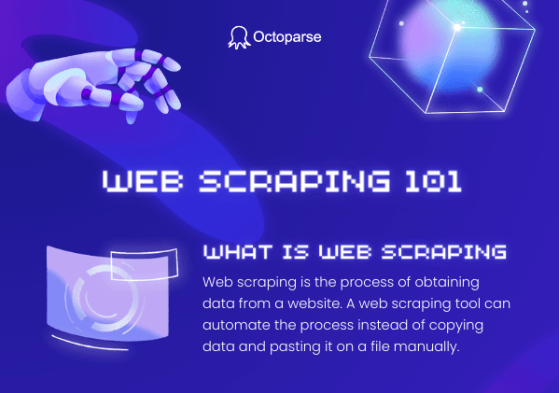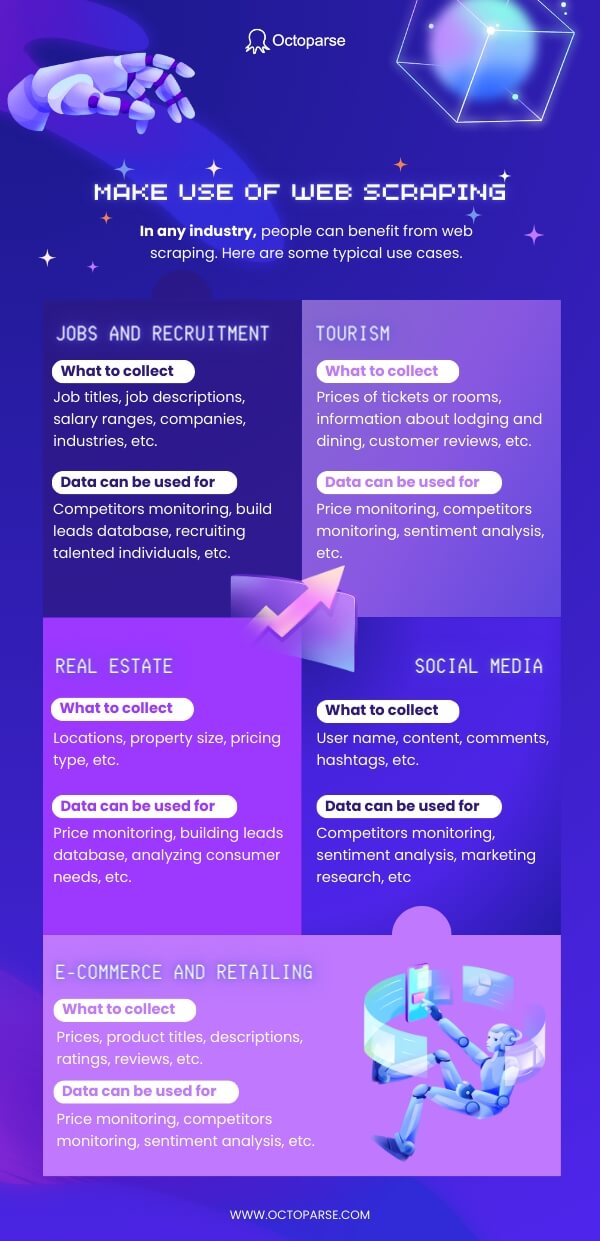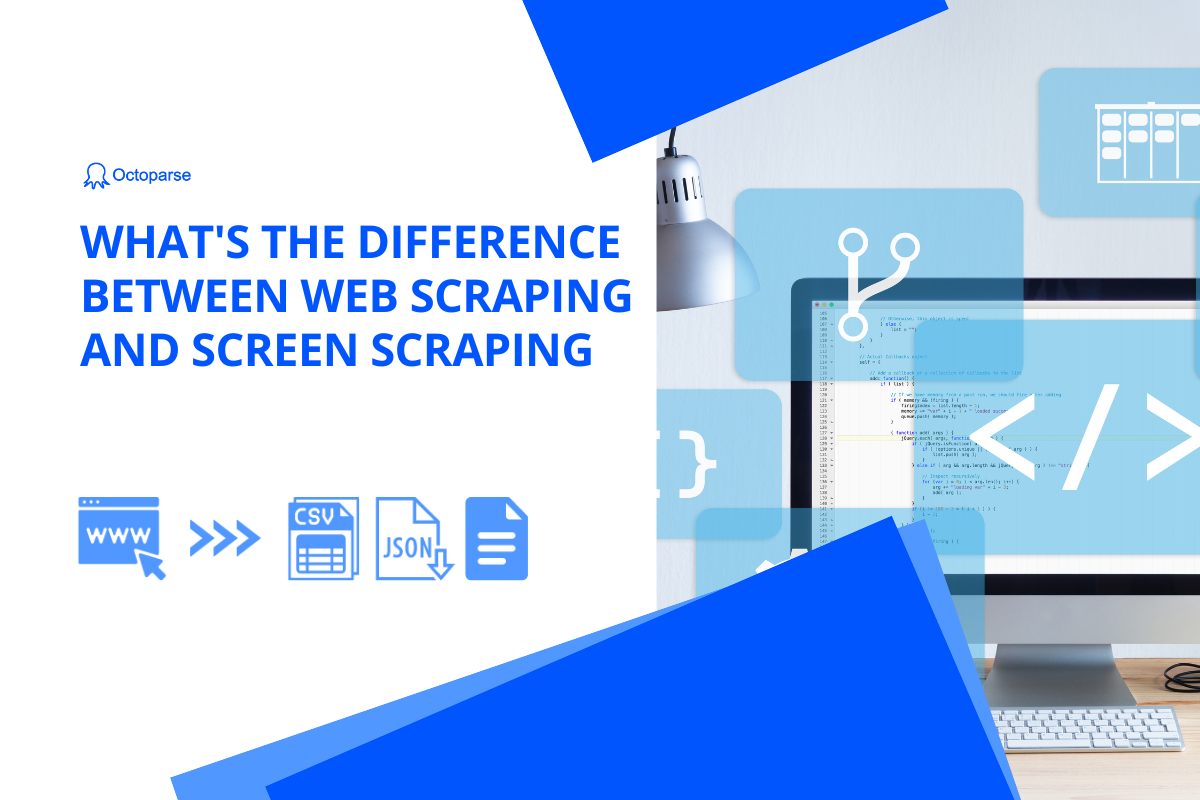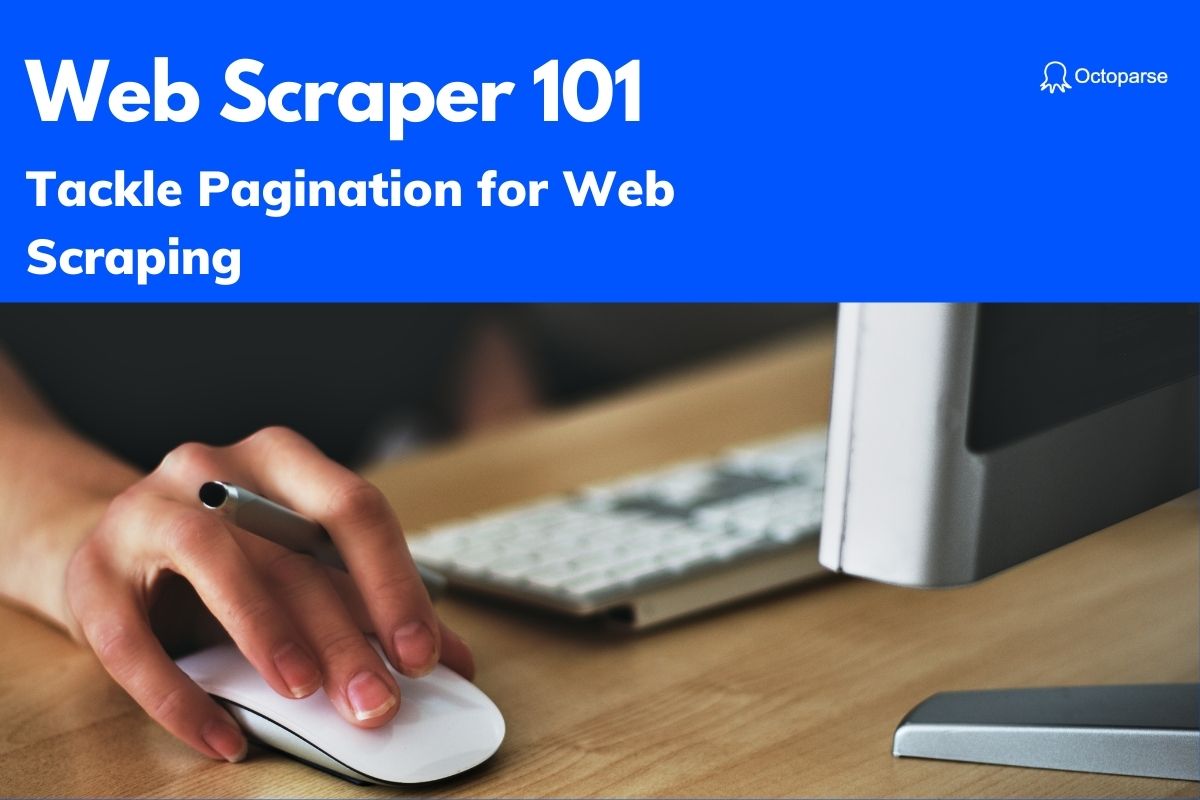What is web scraping? How does it work and how is it used? What are the pros and cons of web scraping? Similar questions keep coming up all the time. So this basic intro comes in and will lead you into the world of web scraping, then answer all questions that concern you.
What is Web Scraping
In short, web scraping is a way to download data from web pages.
You may have heard some of its nicknames like data scraping, data extraction, or web crawling. Among these, web crawling could be narrower and refer to data scraping done by search engine bots. But in most cases, they all refer to the same meaning – a programmatic way to pull data from the web.
In essence, web scraping is a dedicated data collector who captures the exact set of data you want from a load of web pages and makes it into a neat file for your download and further use. It helps fetch data like product information, phone numbers, email addresses, articles, etc., from websites and organize it into certain forms like Excel, CSV, HTML, etc., or databases like Google Sheets.
See how Wikipedia explains web scraping:
“The content of a page may be parsed, searched, reformatted, its data copied into a spreadsheet or loaded into a database. Web scrapers typically take something out of a page, to make use of it for another purpose somewhere else. An example would be to find and copy names and telephone numbers, or companies and their URLs, or e-mail addresses to a list (contact scraping).”

Read the article in infographics
What is the Point of Web Scraping
Big Data and Automation are no longer new concepts in the current business world. People use them to improve their efficiency and effectiveness.
Big data is big for the amount. Automation is about getting things done on autopilot. Web scraping is good at both – getting voluminous data fast with little human labor required.
In the context of big data collection, web scraping is the rescue. If you want to train a machine learning model, a great amount of accurate input data will make you smile. This data will teach your model important lessons and get you a more intelligent algorithm. That’s when web scraping plays the ace – to grab your data efficiently from a number of websites and get it into a machine-readable format for quick use.
Well, not everyone has an AI model to train, but most of us need to collect data for different purposes. Web scraping’s nature of automation improves people’s working efficiency and eliminates human errors. Lay back and let the robot do what is repetitive.
How Does Web Scraping Work
Websites’ data is written in HTML files. Browsers like Chrome and Firefox are tools that read the HTML file to us. Therefore, no matter how diverse web pages are presented to us, every string of data we see in the browser is already written in the HTML source code. With XPath, a language that locates elements on the page, you can trace what you see in the code.
Web scraping finds the right data according to where it locates and takes a series of actions, such as extracting the selected text, extracting the hyperlink, inputting preset data, clicking certain buttons, etc., just like a human, except that it surfs the Internet and copies the data fast around the clock and feels no fatigue.
Once the data is ready, you will be able to download it from the cloud or to the local file for any further use.
How is Web Scraping Used
Who uses web scraping and how does it empower them? Read the use cases below, and then you may discover how web scraping could benefit you as well.
Who is using web scraping
- Many industries can benefit from web scraping including:
- jobs & recruitment
- consultancy
- hotel & travel
- eCommerce & retailing
- finance and more
- marketing
They get data mostly for price monitoring, price comparison, competitor analysis, big data analysis, etc., that serve their decision-making process and business strategies.
For individuals, web scraping helps professionals like:
- data scientists
- data journalists
- marketers
- academic researchers
- business analysts
- eCommerce sellers and more
They can apply web scraping to obtain data that supports their sales, marketing, research, and analysis.

Does web scraping sound like a big undertaking to you? Believe me, it is not. It can be used in many trivial ways and help you out of tedious, repetitive work. Basically, if you need data that could be found on websites and you don’t want to do mind-numbing copies and pastes manually, you use web scraping.
Read also:
- How Dealogic Gets Empowered with Content Aggregation
- E-commerce Product Tracking for Successful Reselling
- Web Scraping In Marketing Consultancy
- Web Scraping Manages Inventory Tracking in Retail Industry
What are the most scraped data and websites
According to the post Most Scraped Websites, e-commerce marketplaces, directory websites, and social media platforms are the more scraped websites in general. Websites like Amazon, eBay, Walmart, Yellow Pages, Craigslist, and social media platforms like Twitter and LinkedIn are among the popular.
What data are people getting from these sites? Well, everything that serves their research or sales.
- Online product details like stock, prices, reviews, and specifications;
- Business/leads information like stores’ or individuals’ names, email, addresses, phone numbers, and other information that serve any outbound gestures;
- Discussions on social media or comments on the review pages that offer data sources for NLP or sentiment analysis.
The need to migrate data is also one of the reasons people choose web scraping. A scraper then works out like a grand CTRL+C action and helps copy data from one place to another for the user.
You may be interested in web scraping business ideas to discover more detailed information about how web scraping is used in practical scenarios.
The Pros and Cons of Web Scraping
Because of its accuracy and efficiency, web scraping empowers individuals and businesses in many ways. However, worries always exist – will it be too complicated to handle? Is it hard to fix and maintain? Well, fair questions. If you get the opportunity to dive into it, you will see the advantages of web scraping very likely outweigh what means to you the tricky part.
The advantages of web scraping
High speed
It is self-evident that web scraping can help people get data faster. It may be the core reason people resort to web scraping. Compared to manually doing this, a web scraper can execute your commands automatically, according to the workflow you have built for it. Each step of work that would have taken up your time will be done by the scraper.
Once you set it up, it will run for you relentlessly, getting all kinds of web data fast from different websites. If you wanna try how fast a scraper can be, I recommend you try our scraper templates. You may try an Amazon scraper to gather product details or product reviews and see how a scraper can get you hundreds of well-structured data lines in just a minute.
Thus, web scraping is a valuable tool to study market trends and gaps, the voice of your customers, and the gestures of your competitors since it helps grab this data fast and easily from all different sources.
Download Octoparse to witness the speed of web scraping now.
“Time is money!”
——Benjamin Franklin
Cost-effectiveness
Web scraping is widely accepted by not only big companies but also SMBs. It just saves money.
First of all, hiring a development team would cost a lot. Looking for the right talents, dealing with leadership and management stuff to put them together and work effectively, and human resources issues, all of these are time-consuming (and sometimes psyche-consuming).
Web scraping takes repetitive work without the need for a coffee break. Unless you have a long-term development plan to carry out (or you have a big budget to squander), web scraping is worth a try.
The returns of setting up a scraper (or a set of scrapers) can be considerable.
For example, if you want a series of product price information and get it updated daily for a year, you may spend a few days or even weeks configuring the scrapers, testing, and fine-tuning it. Once it is well-built, it can work for you as long as you need it. Fresh price data will be delivered to you every morning, more punctual than the employees in your office.
Well, it is not a once-for-all work. You may spend some time maintaining the scraper# now and then, but it saves you a grand number compared to the cost of data delivery for 365 sets of price data a year.
Related Reading: How Does Web Scraping Cost
Compatibility and flexibility
he flexibility of web scraping enables you to get data exactly in the form you need it. For example, a regular expression is one of the ways to get your data cleaned. You can set commands with regex to refine the strings of data by adding a prefix, replacing A with B, cutting certain bytes of data, etc.
You can use Regex to remove the string “(415)” from every number in your spreadsheet if you are scraping San Francisco local business numbers for your telemarketing system. Data can be cleaned as the scraper processes.
File formats also make things easier. Octoparse scrapes web data into EXCEL, CSV, HTML, and JSON formats. These files are compatible with most apps and systems of data management, data analysis, and visualization.
An Octoparse user once told us that he is running a price comparison website. He set the tasks to run daily so that the prices were fresh. The data scraped is automatically exported to his database which connects to his website.
A web scraper can be a data pipeline that extracts data from the web, cleans it, organizes it into the right format, and copies it to your database which could be then uploaded to your websites and systems. You can’t imagine how an individual could run and maintain a website by himself, getting the data on it refreshed every day without web scraping.
Capacity to get data that API can’t
API is short for Application Programming Interface. An API gives people access to the data of an application or system that is granted by the owner.
According to Wikipedia:
“An API is a connection between computers or between computer programs. It is a type of software interface, offering a service to other pieces of software. One purpose of APIs is to hide the internal details of how a system works, exposing only those parts a programmer will find useful and keeping them consistent even if the internal details later change.”
Hence what data you can get through API highly depends on which part of the information is open to the public. In most cases, applications and services would offer only limited access to the public free of charge or sometimes at a cost.
The specification to build an API connection varies from app to app. If you are looking for data from only one or a few sources, and luckily the data you need is all granted, you can study the API specification and take advantage of it. Honestly, maintaining an API connection could be easier than maintaining a web scraper.
A web scraping tool can become a data console where you gather data from different websites with a series of scrapers and become a data pipeline when you connect the tool to your database. A web scraper can ignore the limit of API and extract what data you can see on the browser. Therefore, web scraping is more customizable, and when you need data from multiple sources, more powerful as an aggregator.
The disadvantages of web scraping
Web scraping is powerful, and you may have heard of some of its’ limits and wonder if you are able to deal with them. For example, during the scraping, we can get blocked by the target websites. In this section, we will have a closer look at them.
Tips:If you want to know more possible obstacles, check article 9 web scraping challenges are discussed. Octoparse has its customizable solutions to different situations. If you are stuck in any one of these issues and wonder if Octoparse can be your alternative solution, feel free to contact us at support@octoparse.com. Our colleagues are happy to help.
Start with a learning curve
Web scraping tasks can be a lot easier with a no-code web scraping tool like Octoparse since a non-coder does not have to learn Python, R, or PHP from scratch and can take advantage of the intuitive UI and the guide panel.
However, even a web scraping tool takes time to get familiar with because you have to understand the basic idea of how a web scraper works so that you can command the tool to help you build the scraper.
For example, you shall know how the data is weaved into an HTML file with different HTML tags and structures. You may learn the basics of Xpath to locate the data you need. This is also what I learned (and more) throughout my journey with Octoparse.
Your IP may be blocked
Web scraping is about frequently visiting a website or a set of web pages, sometimes clicking and sending many requests in a short period of time (so as to capture the required data on the pages). Because of the abnormal frequency, your device or IP may be detected as a suspicious robot that is executing malicious attacks on the service.
IP blocking is likely to happen when you scrape websites that are protected with strict anti-scraping techniques, such as LinkedIn and Facebook. The tracking and detection are mainly based on the IP footprint. Therefore, IP rotation or using IP proxies is an important technique for anti-blocking.
This is inevitable due to the speed of web scraping, while solutions like IP proxies and Cloud services offer a way out. Learn more about web scraping limitations.
Web scraper requires maintenance
The scraper is built to grab data according to the HTML structure. If the website you are scraping has changed its structure, for example, the data you need is moving from place A to place B, you then have to amend your scraper to adjust to the change.
We have no control over the external website, hence only keeping up with it. As long as you get a hang of a web scraping tool, and become familiar with the anti-scraping tricks, it would be easier for you to react to these changes.
How to Start Web Scraping
There are a lot of crash courses on platforms like YouTube and Medium to teach people how to start learning web scraping with Python. Honestly, not everyone is good at coding. If you are a total newbie in programming, you can start with a no-code or low-code method. It can be a perfect choice because you can still get the data you want without writing any line of code.
A use case is that a user needs to scrape YouTube data for marketing purposes. But she could not write a line of code. So she worked in Octoparse, a no-code web scraping tool.
Octoparse: A No-code Solution for Web Scraping
If you are looking for a way to get data with web scraping and want to start easy, a no-code tool would be a nice pick even though you are new to it. Compared with writing scripts to build scrapers, using a no-code tool like Octoparse is definitely more time-saving and effortless.
When the user we mentioned above started using Octoparse, it only took her about two weeks to get familiar with the software and learn about the basics of HTML and XPath (these can help locate elements on the page more accurately). Then she successfully built a YouTube scraper herself and got the wanted data. If you are interested in this story, you can check the article on how a marketer made use of no-code web scraping at work on Medium.
And here are some resources you may need along the way as you get onboard:




